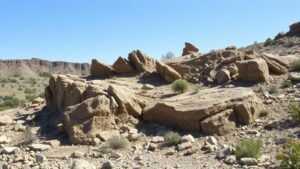The Role of Rare Earth Elements in Tracing Epithermal Gold Systems
The Role of Rare Earth Elements in Tracing Epithermal Gold Systems
Epithermal gold systems are notable for their economic significance in the mining industry, particularly in regions with active tectonic processes. These systems typically contain gold in conjunction with other valuable minerals. In this context, rare earth elements (REEs) serve as crucial indicators for geologists and mineralogists, allowing them to trace and understand the formation and evolution of these deposits. Understanding the role of REEs can enhance exploration strategies, leading to more efficient resource extraction.
Understanding Epithermal Gold Systems
Epithermal deposits form from hydrothermal fluids at relatively low temperatures (200-300°C) and shallow depths (usually less than 1,500 meters). The name “epithermal†is derived from the Greek words meaning “on the earth,†indicating the upper crustal environment where these deposits are found. Characteristics of these systems include:
- Presence of boiling conditions that lead to the precipitation of gold.
- Association with volcanic activity, often occurring in tectonically active regions.
- Presence of various metal and non-metal minerals, influenced by temperature and fluid composition.
Typical minerals that accompany gold in epithermal deposits include silver, lead, and a suite of pathfinder elements, such as arsenic and antimony, which have long been utilized in detecting these systems. But, the role of REEs in tracing these deposits is gaining recognition due to their unique geochemical properties.
The Role of Rare Earth Elements
Rare earth elements, comprising the 15 lanthanides along with scandium and yttrium, are characterized by their similar chemical properties and behavior in geological processes. The presence of REEs in epithermal gold systems can provide insights into the genesis and alteration of these deposits.
- Geochemical Signatures: REEs exhibit distinct fractionation patterns which can serve as fingerprints for specific ore-forming processes.
- Fluid Composition: The ratio of light REEs (like lanthanum) to heavy REEs (like lutetium) in mineralized zones indicates the chemical environment during ore formation.
- Alteration Studies: REE mobility during hydrothermal alteration processes can help delineate the alteration zones associated with gold mineralization.
Case Studies and Applications
The integration of REEs into exploration methodologies has been exemplified by various case studies around the world. For example, the Yanacocha gold deposit in Peru demonstrates how the pattern of REEs can signify hydrothermal activity and the potential for gold mineralization. Studies of this deposit revealed that specific REE distributions correlate with zones of intense alteration and mineralization.
In another instance, the Cripple Creek & Victor Gold Mine in Colorado has shown that the abundance of certain REEs can align with gold-bearing quartz veins. Researchers have utilized REE geochemistry to map ore bodies more accurately, enhancing target delineation in this competitive mining region.
Challenges and Future Directions
While the role of REEs in tracing epithermal gold systems is clear, several challenges remain. The primary difficulty lies in the complex behaviors of REEs during geological processes, which can lead to variable concentrations that obscure direct correlations with gold. Also, extraction and analysis techniques for REEs require considerable resources and technology, often limiting widespread application.
Future exploration strategies should focus on:
- Developing advanced analytical techniques to enhance the detection and localization of REEs in field samples.
- Integrating REE geochemistry with traditional exploration methods to create hybrid models for deposit evaluation.
- Conducting further research into the geochemical behavior of REEs during hydrothermal processes to improve predictive capabilities.
Actionable Takeaways
Understanding the role of rare earth elements in tracing epithermal gold systems offers a powerful tool for modern geologists. By focusing on the following strategies, industry professionals can leverage REE data to enhance exploration and mining efficiency:
- Incorporate REE analysis into routine exploration programs to refine target identification.
- Use case study findings to adapt geological models to local contexts.
- Stay updated on advancements in analytical technologies for REE evaluation.
By integrating rare earth element geochemistry into exploration practices, mining professionals can significantly improve the likelihood of discovering economically viable gold deposits in epithermal systems.


